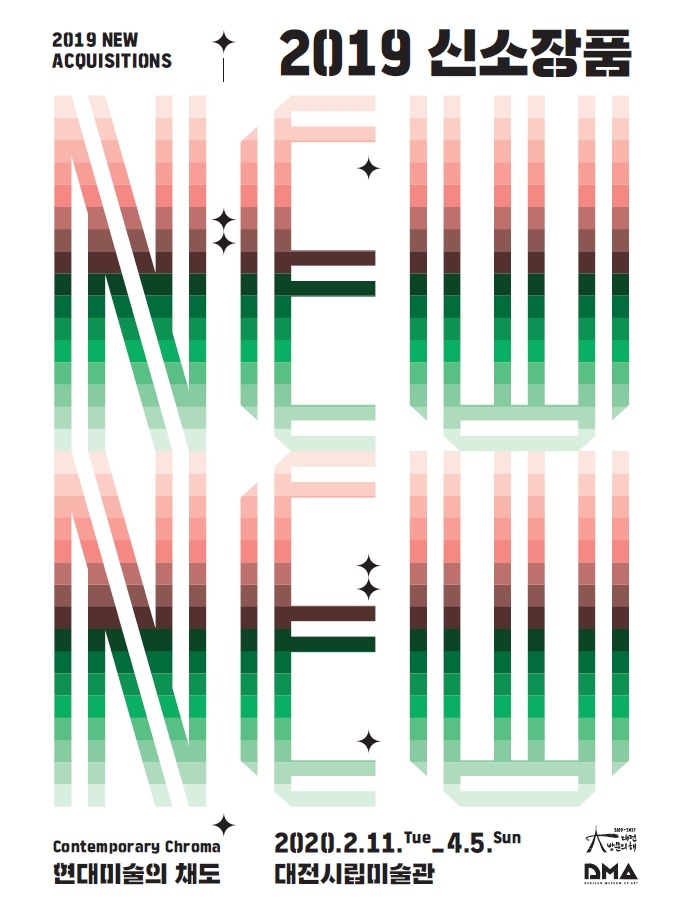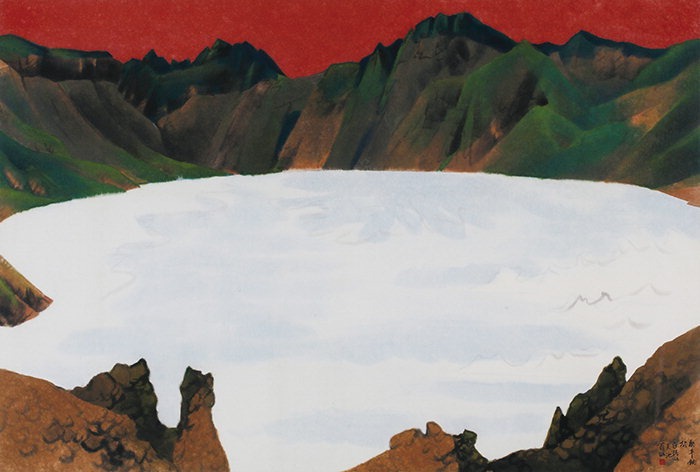
| Period| | 2020.02.11 - 2020.04.05 |
|---|---|
| Operating hours| | 10:00-18:00 |
| Space| | Daejeon Museum of Art/Daejeon |
| Address| | 155, Dunsan-daero, Seo-gu, Daejeon, Republic of Korea |
| Closed| | January 1st, Lunar New Year’s Day (the day), Chuseok (the same day), every Monday (However, if Monda |
| Price| | adult 500won adult·teenage 300won |
| Phone| | 042-270-7370 |
| Web site| | 홈페이지 바로가기 |
| Artist| |
박명규,임립,권영성,박혜경,윤지선,박지혜
|
정보수정요청



|
|
Exhibition Information




The "2019 New collection:Contemporary Chroma" exhibition is an exhibition of works collected by the Daejeon Museum of Art in 2019. One of the main roles of the public art museum is to collect outstanding works that reflect contemporary art flows. The research, exhibition and education of works, and the preservation and management of works and transfer of works to cultural heritage for posterity are all based on the collection of works. Since its opening in 1998, the Daejeon Museum of Art has been collecting significant works based on objective collection policies. For 2020, the collection policy was reorganized in 2005 to cover works representing modern and contemporary Korean art, those representing modern and contemporary art in Daejeon and those representing the country's new media sector. The new collection has a total of 35 points, of which 20 are donated and 15 are purchased. To better convey the meaning of each piece, the exhibition was designed by dividing the three exhibition rooms into donated and purchased pieces, while the four-five exhibition rooms were grouped into three exhibition rooms, which were donated by the late Min Kyung-gap, New Media, Installation, representative paintings of Korea and Daejeon, and young writers from Daejeon. The third exhibition room, which introduces donated works, covers the world of the artist’s works, from 1960s’ works, which contained the non-concept experiments of the late writer Min Kyung-kap, who died in 2018, to those produced in 2017, a year before he was small. His work shows the true aspect of "Korean painting" as it shows the modernity, freshness and persistent experimental spirit that wiped out the past Asian paintings. Also, as shown in the exhibition subtitle "Contemporary Chroma," we want to highlight various aspects of contemporary contemporary art. Exhibition Hall 3 - Gallary 3 Born in 1933 in Nonsan, South Chungcheong Province, Min Kyung-kap will enter the world of ink paintings after entering Seoul National University's College of Fine Arts, which he supported by taking refuge in Busan in 1953 during the Korean War. Since then, he was the youngest person to make a special national war special for his character portraying on a Korean paper when he was a senior at a university. Experimental abstract work was popular due to the influence of abstract expressionism introduced into Korea in the 1960s after his college days, and he joined in as an early member of the Mukrimhoe. The initial work was achromatic abstraction, and after more than eight years of abstract work, he became conscious that it was out of tune with his work. It seems to be due to the trend of the times that there are far more writers working on non-concept lines than on the concept side in the name of modern painting. Modernization doesn’t necessarily have to be an impractical idea." He mentioned this about abstract work in the 1960s. I was once immersed in the pursuit of texture and abstract work trying to dismantle shape in various ways with a modern sense. This was due to the vague notion that by destroying the thick walls of ideas that Korean paintings had at the time, they could be internationally equal to Western art. I couldn't get out of the meeting on whether what we were doing was really ours. So with a determination to start over from scratch, I came to make the decision of a transition from abstract to conception." His work later heads to finding our identity under the theme of nature. The distinctive style of harmony between nature and humans has changed since the 1970s (~1990s), co-existence with nature (1990s), and "into nature" (2000s). Since the 1970s, the mountain, a major material for Min Kyung-kap's paintings, will appear. Breaking away from the stereotypes of traditional ink-and-wash paintings, he gradually begins to omit detailed figures by painting realistic yet color-conscious mountains. During the period of "In Nature" in the 2000s, colorful hues, white flags, and dancheong appeared, which is a sign of the Korean psyche. Later, in the 2000s (natural appearance) and in the 2010s (present appearance), the harmony between nature and man captures the spirit of the nature and the nature of the nature, and the spirit of the nature is set for the rest of the world after 2012. Before his death in 2018, the mountains, which had been painted steadily, will gradually be simplified and replaced with a colorless, ink-and-wash language. Exhibition Hall 4 Yoon Ji-seon Rag face#5004 2015 Sewing on fabric and photograph 135x104cm To question the concept of a fixed ego by immersing and transforming a picture of one's face with a missing and making it look like a completely different person. The colored lines embody grotesque images, a process that emancipates images that have kept women locked up by overthrowing the function of traditional sewing. Lee Sea-hyun Between Red-015JUL02 2015 Oil on linen 250×250cm The extremely realistic images that fill the screen are all portrayed in the unrealistic colors of red, causing tension and anxiety among viewers. The metaphors of death, symbolized by skeletons deployed throughout the work, depict our history of war and division. Kim Joo-hyun Möbius Strip 2016 copper wire, electric plate, LED, 3.3V SPMS 135x170×55cm (2kg) An organic combination of a mesh structure that depicts various changes and possibilities in space that circulate in asymmetric spirals and intersects inside and outside. Realizing the principle of mutual circulation represented by the band of Mobius, the effect of LED light allows one to feel the illusion of space by cohesion and diffusion. Kim Yun-chul Chroma 2019 Acrylic, aluminum, polymer, LED 200x150x150cm (140kg) The three circles originated from the myth of the "Uroboros," a snake that bites its tail in a structure that is connected like a Mobius band. The surface of the work is covered with about 300 cells, a unique patterned image, or chroma, because the cell structure is subjected to different pressures depending on the Kinetic device. Park Jiye No one is there 2019 Single channel HD video, soundtrack, colour 23 minutes 45 seconds 23 min 45 sec The sewage treatment plant in Gumi-dong, the background of the work, is a space that has remained neglected since it was suspended due to collective complaints about the odor shortly after completion. As such, the author indirectly sheds light on the context in which the hidden emotions and spaces of the members of society form relationships through the scattered spaces around us. Exhibition Hall 5 Kim Jung-hun Still standing under a perimmon tree at the Malmok marketplace 1994 Acrylic on Canvas 207x303cm Kim Jeong-hun is a writer who represents folk art in the 80s and interprets the ideology of the new art most self-reliance. Still standing under the persimmon tree in the horse ranch.> is one of the monumental works of Korean folk art presented before the 100th anniversary of the 1994 Donghak Peasants Revolution. Kim Ho-deuk Rapids 2018 Ink on Cotton fabric 160×415cm Kim Ho-deuk is a writer who has continued to experiment with conventional ink-and-wash paintings as much as his rough brush strokes, coming between real-life-based and realistic ideas. Although water is the subject of water, rapid flow is a natural reminder of water motion by expressing the stone and surrounding area with quick brush strokes instead of drawing water directly. Park Myungkyu Red and blue 1974 oil on canvas 72.7x60.6cm (3EA) It doubles the Korean sense of beauty by placing contrasting colors with "hot abstracts" and "cool abstracts" and introducing white margins. Forms born through simple lines, dots, seeping and seeping techniques, while using blue, red, white and black, which belong to the five colors, show aesthetics close to the Oriental spirit. Lee Jonghyup Transformation 2 1975 oil on canvas 128.5 x 96.5 cm The painting was exhibited in 1976 during the period when he was a member of the ‘19751225 Group’, which was the driving force of modern art in Daejeon The human body’s convenience, which connects space to a structural pattern stacked up with suppressed historical sentiments, fills the entire screen. This is a piece that allows you to look at a page from Daejeon Art History in the 1970s. Lim Lip Story of an old house 1985 oil on canvas 145.5x112cm It was specially selected at the 29th Korea Art Exhibition. Scrape and wipe it with a knife and cloth on top of the thick, red paint. It was completed by repeating the work of drawing lines. The calm and subdued images illustrate the character of the author’s early work, which is full of the warmth of his hometown. Jeon Won-gil Botanic Landscape-1 2015 acrylic on canvas, pint marker 160×132 cm (3EA) We put wild plants that live near the workroom in a pot and grew them for a year to study the characteristics of plants. The painting was completed by working with more than 1,000 drawings and hundreds of photographs. The author solves the relationship between separation and connection in an independent way by transparently superimposing the purity of color and the landscape situation. Ham Myung-su Alive 2019 Oil on canvas 259.1×193.9cm It is a natural reflection of the surroundings after moving the workroom to the countryside, unlike previous works that focused on the touch of the brush. The color mix is created through painting and scraping before the paint dries. in the same shape as if moving at the same time. It embodies a sense of creation and extinction by capturing vital energy. Kown Young-sun A graph of the relationship between the range and the road 2015 Acrylic acid on canvas 162.1×227.3cm metaphorically expressing the progress and development of cities in Korea through graphs, and the social structure is the relationship of things within cities, the relationship between man-made and natural objects. Recombine the impact with wit. This causes modern people tired of the gray city to take different views and ideas about the environment. Park Eun-young Park Forest of rebirth 2014 Acrylic on canvas 130.3x162.2cm After projecting the collected natural images onto the canvas onto a projector, the screen is completed through the brush, by darkening the room and setting up a visually limited environment. It induces accidental spillage and color sweep effect. He wants to place himself in the particular phenomenon that emerges here and find where the work self-expresses. Park Hye-kyung Park Hye-kyung Temporal record - record 01 2015 Acrylic on canvas 112.1×145.5cm It constructs a screen by repeatedly building line images that visualize areas that are invisible to the eye, body sense and memory. Drawing repeatedly in the work, observing the relationship with time and making assumptions about the object, and having a close relationship with the object. It is a meditative and suggestive process of healing the writer himself.
